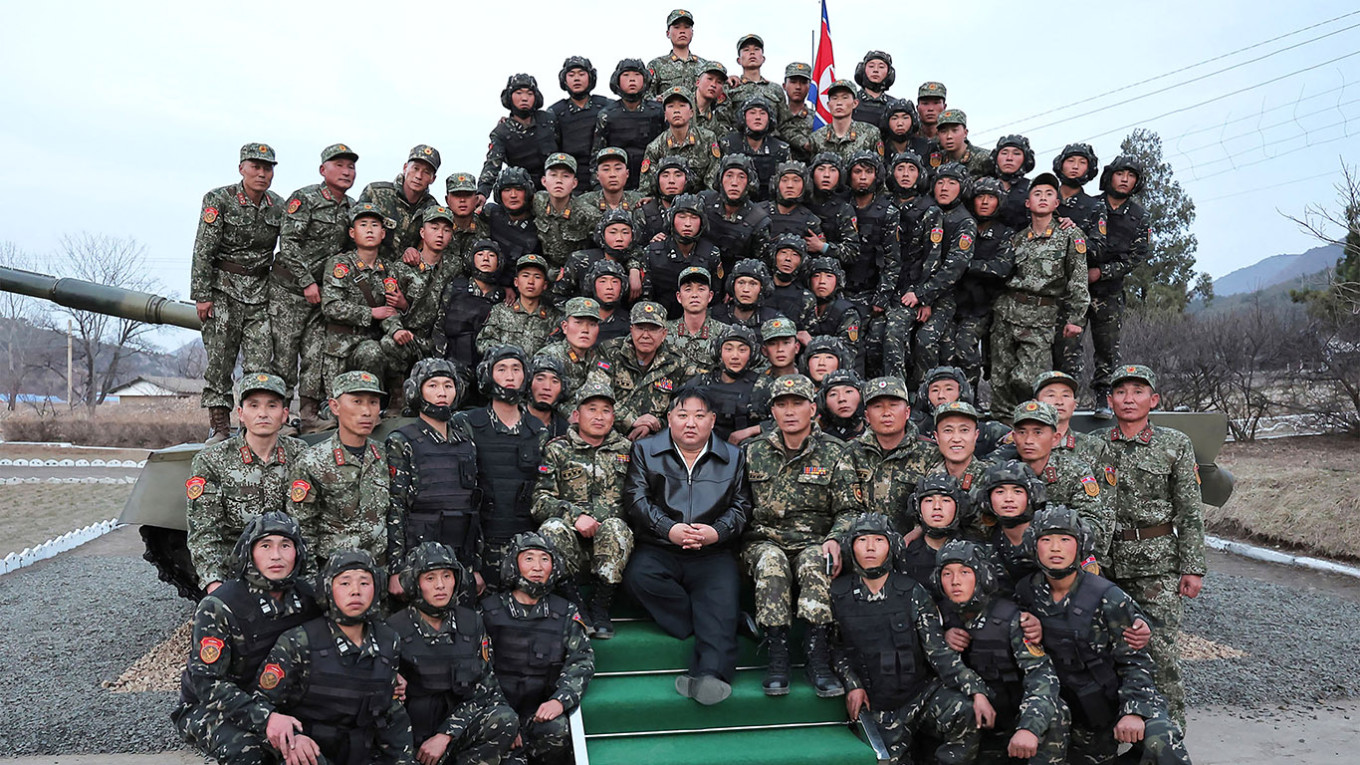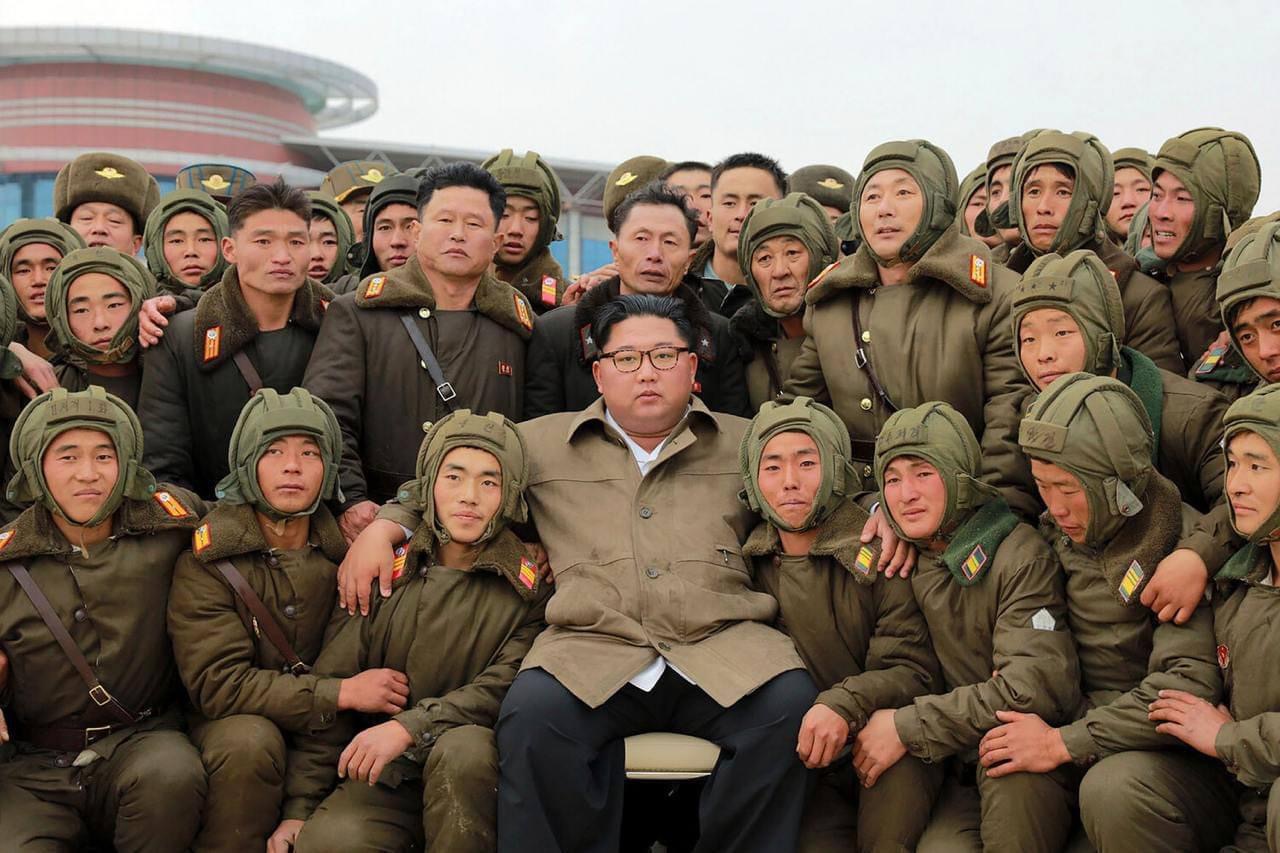
North Korean leader Kim Jong Un poses for a photo with soldiers of the Seoul Ryu Kyong Su Guards 105th Tank Division of the Korean People’s Army.
[ KCNA VIA KNS]
North Koreans are among some 50,000 soldiers launching a major assault on Ukrainian positions in Russia’s Kursk region, where a three-month-old Ukrainian incursion has stalled.
A Ukrainian commander told CNN that the North Koreans were involved in direct combat operations in Kursk, as well as defensive operations in the neighbouring Belgorod region of Russia and Russian-occupied Ukrainian territories.
“Mostly, the tasks are defined as the second echelon of defence. In the Kursk region, these are direct combat operations,” said the commander, adding that specialist artillerymen and snipers were among the personnel.
“These groups will be directly involved in combat operations in the short term on the territory of Ukraine. They are highly likely to emerge in the occupied territories of Ukraine as well.”
The first action by North Korean troops came as the so-called Hermit Kingdom and Russia ratified a major defence treaty stipulating mutual military aid between the two countries.
Signed in June, the Comprehensive Strategic Partnership treaty will take effect when both sides exchange the finished documents, which were ratified Nov. 12, 2024, said the state-run Korean Central News Agency.
The treaty requires the signatories to provide immediate military assistance if either is attacked. It also calls for the two countries to co-operate in efforts to establish a “just and multipolar new world order” and strengthen co-operation in various sectors, including peaceful atomic energy, space, food supply, trade and economy.
Some speculate the ratifications could signal North Korea’s formal entry into the near-three-year-old Russia-Ukraine war.
Ukraine and North Korean troops are said to have engaged in small-scale fighting while Ukraine’s army fired artillery at North Koreans in the Kursk border region where some 6.1 million Soviet and Nazi German soldiers clashed in the summer of 1943.

Kim with troops destined for their inevitable deaths in Russia-Ukraine.
Former Ukrainian officials have suggested the North Koreans could suffer casualty levels of up to 90 per cent.
In what has been called the single largest confrontation in the history of warfare, the German offensive and subsequent Battle of Kursk proved one of the priciest encounters of the Second World War, costing the Germans an estimated 480,000 casualties and more than 4,600 tanks and assault guns.
The Red Army suffered some 1.7 million casualties and lost as many as 9,000 tanks and assault guns. But after seven weeks of intense battle, including fierce house-to-house fighting and hand-to-hand combat, it had regained territory along a 2,000-kilometre front and seized the strategic initiative for the balance of the war.
Kursk marked the first time a German strategic offensive—the failed Operation Citadel—was halted before it could break through enemy defences and penetrate to its strategic depths. It has been called the “last gasp of Nazi aggression.”
The current situation was still developing at press time.
But with the future of U.S. aid uncertain, North Korea’s troop dispatch threatens to escalate the Russia-Ukraine war. South Korea, the Americans and their partners also worry about what Russia could give North Korea in return. Possible Russian transfer of sensitive technology to enhance Pyongyang’s already-advancing nuclear and missile programs would be an alarming development for the U.S. and its allies.
Russia-North Korea military and other co-operation has been building for some time. South Korea’s spy agency said recently that North Korea had sent more than 13,000 containers of artillery, missiles and other conventional arms to Russia since August 2023 to replenish its dwindling weapons stockpiles.
The treaty could prove a boon to Russia’s diminishing fortunes in Ukraine, which Russian leader Vladimir Putin ordered invaded on Feb. 24, 2022. U.S. defence officials said in October 2024 that Russia has suffered more than 600,000 casualties in less than three years, including over 100,000 dead.
The Americans say some 32 vessels of Russia’s Black Sea naval fleet have been damaged or destroyed, forcing its withdrawal to safer ports, and two-thirds of its prewar stock of tanks are gone. These losses have forced the Kremlin to dredge through warehouses of Soviet-era military equipment to retrofit, then deploy.
Ukrainian media reported Nov. 13 that Russian forces had had suffered the deadliest day of the war, losing 1,770 soldiers, 56 artillery systems, 49 armoured combat vehicles and 24 tanks in the previous 24 hours. It claimed total Russian casualties since the invasion had topped 715,000.
South Korea’s spy agency said recently that North Korea had sent more than 13,000 containers of artillery, missiles and other conventional arms to Russia since August 2023.
As formidable as North Korea’s numbers appear, its soldiers are lacking combat experience, their last major conflict the 1951-’53 war with South Korea which, lacking a peace agreement, has never technically ended.
Some North Korean troops fought Americans in Vietnam. It has since sent officers to Africa as trainers and advisers. Russia-Ukraine, however, is something completely different.
“While not denying the hardiness and toughness of an individual North Korean soldier,” reported Al Jazeera, “there is no one in the North Korean armed forces who has had any experience of fighting a mechanised conflict using 21st-century weapons.
“Drones, sensors, and constant surveillance of the battlefield will mix with the old and proven tactics of combined arms warfare, trench clearing and the use of long-range precision artillery.
“This will be vital for North Korea if it aims to successfully wage war against South Korea.”
Former Ukrainian officials have suggested they could suffer casualty levels of up to 90 per cent.
“I would say that could be an accurate assessment. They are not well-trained, and it is a very unfamiliar environment for them,” defector Hyunseung Lee, who spent 3.5 years with a North Korean artillery and reconnaissance battalion in the early 2000s, told Radio Free Europe/Radio Liberty.
Lee, who co-founded the Washington-based North Korean Young Leaders Assembly to foster the development of new leaders among the country’s defectors, has taken to social media to convince North Korean soldiers that “there is no reason for you to sacrifice your lives on a foreign battlefield.”
Accompanied by senior staff, including three generals, the North Korean units arrived in Russia several weeks ago without equipment and immediately embarked on a crash course in operations and command and control protocols.
Leaked video showed Russian instructors teaching the North Koreans Russian commands and apparently demonstrating landmine detonation.
“They’re totally not ready,” said Lee.
North Korean men are required to join the army at the age of 17 and usually serve 10 years said Lee, who defected to the United States a decade ago.
“They have never engaged in major conflict. They don’t have real battle experience.”
They received night-vision and thermal-imaging devices, as well as illuminated sights, upon their arrival.
A group of defectors, meanwhile, has handed Ukrainian officials propaganda leaflets urging Pyongyang’s fighters to abandon the war against Ukrainian troops in Russia.
The former North Korean citizens delivered the material, which includes written instructions and audio messages for North Korean fighters on how to defect, to Ukraine’s embassy in Seoul, South Korea’s Yonhap news agency reported.
Group leader Jang Se-yul, said Kyiv’s military “could secure mass surrender and defection among North Korean soldiers if proactive psychological warfare is mobilized.”
Advertisement





















